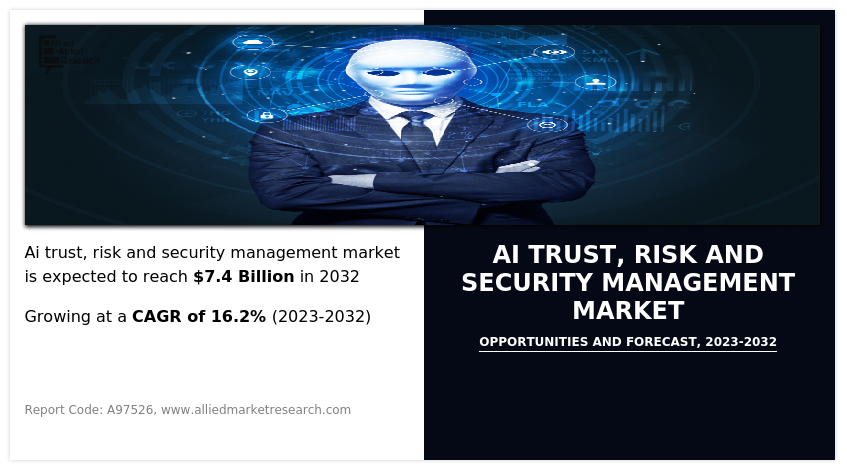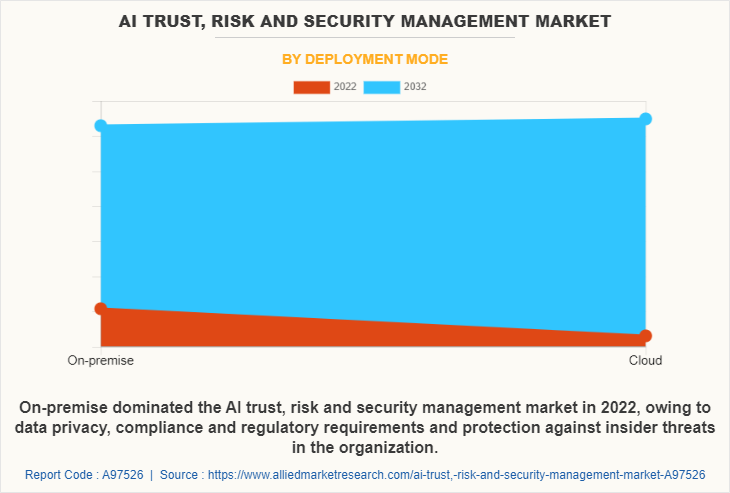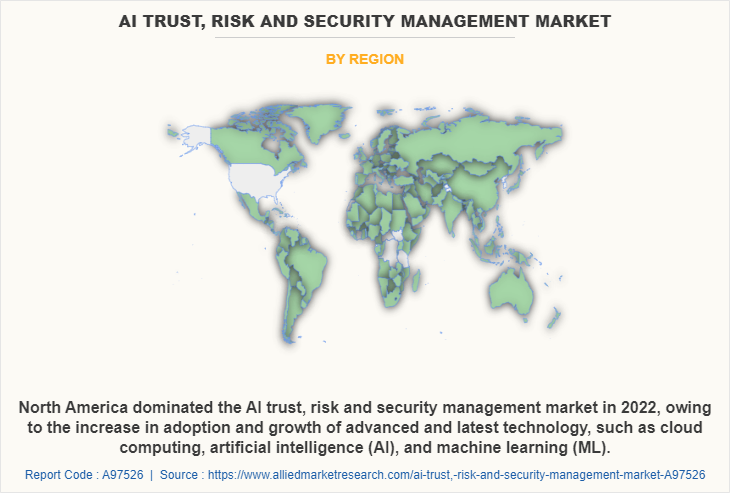AI Trust, Risk And Security Management Market Insight, 2032
The global ai trust, risk and security management market was valued at $1.7 billion in 2022, and is projected to reach $7.4 billion by 2032, growing at a CAGR of 16.2% from 2023 to 2032.
Factors such as increase in efforts of government to deploy AI technology and secured and convenient data storage primarily drive the AI trust, risk and security management market growth. However, comprehensive ethical norms as a foundation for Al and insufficient awareness of Al hamper market growth to some extent. Moreover, Al may dramatically lessen gender-prejudice and are expected to provide lucrative opportunities for market growth during the forecast period.

AI trust, risk and security management refers to a variety of AI lifecycle components. These components address the creation, introduction, and continuous utilization of AI applications. The field of artificial intelligence (AI) has grown swiftly, allowing companies to forecast events with greater accuracy, automate procedures, and make choices with greater speed and precision. The potential risks associated with data leaking, tampering, and malicious assaults are however present along with this power of AI. Businesses must establish technology and practices that go beyond conventional security safeguards to secure AI apps and services and guarantee AI is employed securely and ethically. Here, AI trust, risk and security management comes to play as it enables secure and effective application of AI. The primary goal of Al trust, risk, and security management is to bridge the ethical responsibility and technical advancement gaps.
Some of the main factors projected to drive market expansion include increased government attempts to utilize Al technology, the rise in demand for Al systems that can be trusted, and the rise in demand for Al decisions that are clear. However, it is anticipated that high ethical standards and a lack of knowledge in Al may impede market expansion. However, because of the widespread usage and progress of Al technology within the predicted period, these factors are projected to be greatly diminished.
The AI trust, risk and security management market is segmented on the basis of component, deployment mode, enterprise size, industry vertical, and region. On the basis of component, it is bifurcated into solutions and services. On the basis of deployment mode, it is bifurcated into on-premise and cloud. On the basis of enterprise size, it is bifurcated into large enterprise and small and medium-sized enterprise. On the basis of industry vertical, it is divided into IT and telecom, BFSI, manufacturing, healthcare, retail and e-commerce, government and others. On the basis of region, it is analyzed across North America, Europe, Asia-Pacific, and LAMEA.
The market players operating in the AI trust, risk and security management industry are International Business Machines Corporation, SAP SE, SAS Institute Inc., Oracle Corporation, Rapid7, At&t Intellectual Property, LogicManager, Inc., ServiceNow, Moody's Analytics, Inc., and RSA security LLC.. These major players have adopted various key development strategies such as business expansion, new product launches, and partnerships, which help to drive the growth of the AI trust, risk and security management industry globally.

By deployment mode, the on-premise segment dominates the global AI trust, risk and security management market size, owing data privacy, compliance and regulatory requirements and protection against insider threats in the organization. This is attributed to trust, risk, and security management that play a crucial role in ensuring business continuity by implementing robust backup strategies, disaster recovery plans, and resilience measures. In addition, on-premises segment also provides effective management of trust, risk, and security that includes techniques such as algorithmic transparency, and auditability, enabling organizations to understand and validate the behavior of the system. The cloud segment would also showcase the fastest growth throughout the forecast period, owing to the integrity, confidentiality, and availability of AI systems and data. Key factors related to the cloud segment in AI trust, risk and security management are storage, data protection, secure infrastructure and identity and access management.

Region-wise, North America dominated the market share in 2022 for the AI trust, risk and security management market share, owing to the increase in adoption and growth of advanced and latest technology, such as cloud computing, artificial intelligence (AI), and machine learning (ML). The integrated smart processes and breakthroughs of technical developments have entirely revolutionized the landscape of the IT industry and, in turn, encouraged the drive for the implementation of efficient and secure AI solutions. However, Asia-Pacific contributes the fastest growth in the region, owing to increase in adoption of increasing adoption of AI, data sensitivity and privacy concerns and cybersecurity threat landscape.
Top Impacting Factors
Secured and Convenient Data Storage
For improved Al TRiSM, researchers and engineers need better data. The learning algorithm (such as a deep-neural network model) and the datasets used to train and test that algorithm both affect how well an Al solution performs. Algorithms and datasets have historically received substantially more attention in Al research due of its critical importance. Different sectors employ Al TRiSM to establish online and offline data storage capabilities, as well as for real-time offer management, automated checkout systems, and enhanced security of the database analytics. The need for Al TRiSM from data storage applications has also increased dramatically over the past several years Due to the secured access to datasets.
Increasing Efforts of Government to Deploy AI Technology
Businesses and governments all around the world have started a variety of projects to adopt Al and ML technologies and position themselves as market leaders as a result of the expanding benefits of Al. Government entities from numerous nations are establishing councils, new laws and regulations, and frameworks in order to implement Al TRiSM solutions. Increase in public confidence in Al technology and protecting civil liberties and personal information are the key objectives of governments deploying Al TRiSM solutions. In order to identify risk issues for Al technology, many companies have formed committees in collaboration with suppliers of Al solutions, academic institutions, and research centers. For instance, in March 2021, the U.S.-India Artificial Intelligence Initiative was launched by the Indo-U.S. Science and Technology Forum (IUSSTF) with the goal of fostering Al innovation through the exchange of knowledge and experiences, the discovery of fresh opportunities for bilateral cooperation, and the advancement of Al research.
Technology Aspect
AI trust, risk, and security management technology plays a crucial role in ensuring the safe and responsible development, deployment, and operation of artificial intelligence systems. AI systems have the potential to perpetuate biases present in the data they are trained on, leading to discriminatory outcomes. To address this, risk management technologies focus on identifying and mitigating biases in training data, ensuring fairness and equal treatment across different demographic groups.
Moreover, continuous monitoring and auditing of AI systems are essential to identify risks, vulnerabilities, and performance degradation over time. These technologies involve implementing mechanisms for tracking model behavior, detecting anomalies, and providing alerts for potential security breaches or risks. As a result, key players in the market upgraded their services to enhance their services in AI trust, risk, and security management market. For instance, May 2022, Oracle enhanced its comprehensive AI trust, risk and security management and cloud security capabilities with integrated threat management. These innovations are expected to further help ensure that organizations can easily secure their cloud deployments and applications with simple, prescriptive, and integrated services.
Key Benefits For Stakeholders
- This report provides a quantitative analysis of the market segments, current trends, estimations, and dynamics of the ai trust, risk and security management market analysis from 2022 to 2032 to identify the prevailing ai trust, risk and security management market opportunities.
- The market research is offered along with information related to key drivers, restraints, and opportunities.
- Porter's five forces analysis highlights the potency of buyers and suppliers to enable stakeholders make profit-oriented business decisions and strengthen their supplier-buyer network.
- In-depth analysis of the ai trust, risk and security management market forecast assists to determine the prevailing market opportunities.
- Major countries in each region are mapped according to their revenue contribution to the global market.
- Market player positioning facilitates benchmarking and provides a clear understanding of the present position of the market players.
- The report includes the analysis of the regional as well as global ai trust, risk and security management market trends, key players, market segments, application areas, and market growth strategies.
AI Trust, Risk and Security Management Market Report Highlights
| Aspects | Details |
| Market Size By 2032 | USD 7.4 billion |
| Growth Rate | CAGR of 16.2% |
| Forecast period | 2022 - 2032 |
| Report Pages | 346 |
| By Component |
|
| By Deployment Mode |
|
| By Enterprise Size |
|
| By Industry Vertical |
|
| By Region |
|
| Key Market Players | International Business Machines Corporation, Moody's Analytics, Inc., AT&T Intellectual Property, ServiceNow, SAS Institute Inc., Oracle Corporation., Rapid7, RSA Security LLC, SAP SE, LogicManager, Inc. |
Analyst Review
According to CXO's of leading companies, Al TRiSM covers issues such as the right to knowledge and potential legal violations that can result from incorrect use of Al technology. Artificial intelligence governance is clearly needed given the rise in use of AI across a number of economic sectors. In the fields of business, banking, healthcare, and transportation, artificial intelligence is already widely used. The three key areas of focus for Al TRiSM are the interaction between Al and justice, data quality, and autonomy. Increased adherence to technological norms expected to promote market expansion.
In addition, the market for artificial intelligence (AI) TRiSM is anticipated to gain from expanded opportunities as a result of the use of Al to reduce prejudice and gender bias. Furthermore, there is a growth in importance of factors such as transparency while building trust in Al technology. Al governance addresses issues such as access to and control over personal data as well as the moral and ethical implications of using AI. Moreover, Al TRiSM establishes who is in charge of regulating Al and how much its algorithms may change and influence daily lives of people. As a result, it is projected that the market for Al TRiSM would grow significantly over the upcoming years.
Factors such as increase in efforts of government to deploy AI technology and secured and convenient data storage are the upcoming trends of AI trust, risk and security management market.
Al may dramatically lessen gender-prejudice and are expected to provide lucrative opportunities for market growth during the forecast period.
North America is the largest regional market for AI Trust, Risk and Security Management Market
The AI trust, Risk and Security Management Market valued for $1,692.53 million in 2022 and is estimated to reach $7,397.28 million by 2032, exhibiting a CAGR of 16.2% from 2023 to 2032.
Market players operating in the lot in energy market include International Business Machines Corporation, SAP SE, SAS Institute Inc., Oracle Corporation, Rapid7, At&t Intellectual Property, LogicManager, Inc., ServiceNow, Moody's Analytics, Inc., and RSA security LLC. Furthermore, it highlights the strategies of the key players to improve the market share and sustain competition.
Loading Table Of Content...
Loading Research Methodology...


